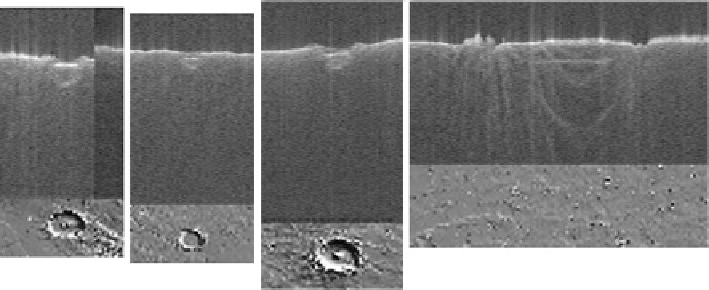Geoscience Reference
In-Depth Information
Fig. 5.4
Martian craters (exposed and buried)
different from that of the crustal material. The analysis of number and dimensions
of the buried basins provided an improvement in the study of the strong contrast
between the northern lowland plains and the southern highlands. In fact, the number
of detected buried craters >200 km in diameter allowed to date the lowland crust
back to the Early Noachian epoch and to deduce that the northern lowland crust
is at least as old as the oldest exposed highland crust, suggesting that the crustal
dichotomy arose early in the geologic evolution of Mars.
MARSIS, probing the physical properties of the subsurface to unprecedented
depth, provided geophysical evidences for the former existence of an ocean in the
Martian northern hemisphere, already suggested by previous observations. On the
basis of Martian surface geology, it is known that in the past, there was abundant
water flowing, as attested by dendritic valley systems (Carr
1996
; Luo and Stepinski
2009
; Di Achille and Hynek
2010
) and wide outflow channels (Carr
1987
; Baker
et al.
1991
). The ancient presence of Oceanus Borealis, an ocean that would have
covered more than 60 % of Mars north hemisphere has been postulated (Baker et al.
1991
).
Studying MARSIS data, Mouginot et al. (
2012
) produced a dielectric map
of the Martian subsurface. Due to the radar characteristics, the map represents
the volume averaged properties of the first 60
80 m below the surface. The
data evidenced significant differences between the two hemispheres: while in the
southern hemisphere, the area characterized by the lowest dielectric values delimits
a quasi-circular area from the pole to 60
ı
S latitude, in the northern hemisphere, the
area distinguishing by low dielectric values extends with three lobes toward lower
latitudes in the regions of Amazonis Planitia (150
ı
W), Chryse Planitia (30
ı
W), and
Utopia Planitia (100
ı
E). The region matches with substantial accuracy the shoreline
which encloses the Vastitas Borealis formation. On the basis of dielectric constants
measured in the region, considerably lower than that of typical volcanic materials,
the presence of low-density sedimentary deposits or huge ground-ice masses or
probably a combination of both has been proven, suggesting the former presence
of an ancient ocean filled by aqueous sediments.

Search WWH ::

Custom Search